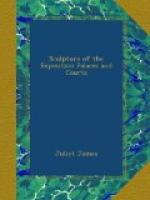A very remarkable figure, her head hanging forward, lies stretched in slumber. It is the sleeping Earth. From her come the great trees whose ramifying roots extend in all directions. Man is seen wresting from her stone and precious metals. Wonderfully has Robert Aitken worked out the Mother Earth idea. She has brought forth many times and yet is ever young. It is keenly interesting to look at “Earth” and then at Michelangelo’s “Night” to see the source of inspiration.
Wildflower
Edward Berge, Sculptor
At sight of your form, I seem now to see
A bright stretch of color across a broad lea,
Where the wildflowers sway to and fro in the breeze,
Where the winds sing soft lullabies up in the trees
Where all is as fresh, free and wholesome as you,
Little Wildflower, blooming, so sweet and so true.
And I come from the flight of my far-away dream
As I look and I listen, to me it would seem
That I hear a small voice in a most charming way
Say, “Goodmorrow! Goodmorrow! Take
time while you may,
Just step up yet closer; I’ll give you a chance
To have something far sweeter than just a bright glance.”
Appendix
The Sculptors
The planning, the placing, the naming of all this noble sculpture has practically been done by two men — the late Karl Bitter of New York, a man of great executive and technical ability as well as of immense inspiration, and A. Stirling Calder, on whom the honor for the great bulk of the work rests. Besides acting as personal overseer for the execution of the sculpture of the Palaces and Courts of the Exposition, Mr. Calder has designed the Nations of the Orient, The Nations of the Occident, The Fountain of Energy, The Stars, Column of Progress and its sculpture, and The Oriental Flower Girl. Since the sculpture is one of the strongest factors of this Exposition, we should extend to Mr. Calder our heart-felt appreciation of all that he has done to help make this Exposition such a wonderful, artistic success.
Robert Ingersoll Aitken
Robert Ingersoll Aitken was born in San Francisco in 1878. He was a pupil of Arthur F. Mathews at the Mark Hopkins Institute of Art and later of Douglass Tilden, the well-known California sculptor. He has done a great deal of very strong, compelling work. The examples of his sculpture seen at the Panama-Pacific International Exposition are of pronounced virility and of fine composition. He is a man who excels in technique. He has done in San Francisco the Victory for the Dewey Monument in Union Square, the McKinley Monument, the Bret Harte Monument and the Hall-McAllister Monument. In the Metropolitan Museum of New York is “The Flame.” At the Fine Arts Palace are a number of works from his chisel — The Gates of Silence, the Gates’ memorial, being by far the finest.




